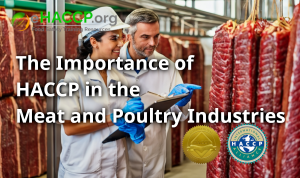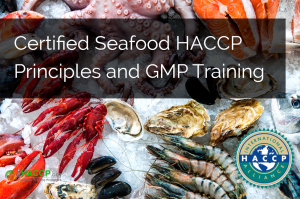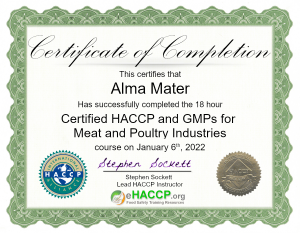
HACCP The International Food Safety Standard for the Future
With new regulations, climate change fears, pathogen resistence to drugs, HACCP is up to the chanllange and will continue to be the international standard.
The concept of Hazard Analysis and Critical Control Points (HACCP) was initially developed in the 1960s by a collaboration between NASA, the U.S. Army Laboratories, and Pillsbury Company. The primary goal was to create a food safety system that would ensure zero defects in foods produced for space missions. Unlike traditional quality control methods that relied heavily on end-product testing, HACCP emphasized preventive measures by identifying potential hazards at various stages of production and implementing controls to mitigate those risks.
This pioneering approach revolutionized the way food safety was perceived and managed. By focusing on prevention rather than detection, HACCP provided a more proactive framework for ensuring food safety, which could be applied across different sectors of the food industry. The system quickly garnered attention beyond its initial scope, leading to its adoption by various regulatory bodies and international organizations.
In 1971, HACCP principles were first introduced to the public at the National Conference on Food Protection. Subsequently, in 1985, the National Academy of Sciences endorsed HACCP as an effective tool for ensuring food safety. The system gained further traction when it was formally adopted by regulatory agencies such as the U.S. Food and Drug Administration (FDA) and later incorporated into international standards by organizations like Codex Alimentarius.
Over time, HACCP has evolved from its original application in space missions to become a cornerstone of global food safety practices. Its adaptability has allowed it to be tailored to diverse industries ranging from meat processing to dairy production and even pharmaceuticals. This evolution underscores not just its robustness but also its critical role in shaping modern approaches to managing food safety risks comprehensively.
Key Principles of HACCP Implementation
The successful implementation of Hazard Analysis and Critical Control Points (HACCP) hinges on a comprehensive understanding of its key principles, which serve as the backbone for ensuring food safety across the supply chain. Central to these principles is the identification and evaluation of potential hazards that could compromise food safety. This involves a meticulous hazard analysis that scrutinizes every step of the food production process, from raw material acquisition to final consumption.
Once hazards are identified, determining critical control points (CCPs) is essential. These are specific stages in the process where controls can be applied to prevent or eliminate hazards or reduce them to acceptable levels. Establishing critical limits for each CCP is another vital principle; it involves setting maximum and minimum values such as temperature thresholds or pH levels that must be met to ensure hazards are effectively controlled.
The implementation does not stop at setting these parameters; it also requires continuous monitoring procedures to ensure that each CCP remains within established limits. This ongoing vigilance helps detect any deviations promptly, allowing for immediate corrective actions to restore control and prevent compromised food safety. Furthermore, verification activities play a crucial role in confirming that the HACCP system is functioning as intended.
Regular audits, testing, and reviews help validate that all components of the system are effective and up-to-date with current standards. Finally, thorough documentation and record-keeping underpin all HACCP activities. Detailed records provide traceability, accountability, and evidence of compliance with food safety regulations.
Success Stories: Industries Benefiting From HACCP
Since its inception, the Hazard Analysis and Critical Control Points (HACCP) system has been a cornerstone in advancing food safety across various sectors. One compelling success story is the dairy industry. Dairy products are particularly susceptible to contamination due to their perishable nature. By implementing HACCP protocols, dairies can meticulously monitor every stage of production—from milking and pasteurization to packaging and distribution—ensuring that potential hazards are identified and controlled before they pose a risk to consumers.
Another sector that has seen significant benefits from HACCP is seafood processing. Given the global demand for fresh seafood and the complexities involved in its supply chain, the risk of contamination is high. Through rigorous hazard analysis and establishing critical control points, seafood processors have drastically reduced incidences of foodborne illnesses linked to fish and shellfish. This not only improves public health but also enhances consumer confidence in seafood products.
The meat industry also stands out as a major beneficiary of HACCP implementation. With numerous high-profile recalls over the years due to contamination issues, adopting HACCP guidelines has become imperative for meat processors. By focusing on critical points like slaughtering, cutting, grinding, and packaging, these companies have significantly minimized risks associated with pathogens such as E.coli and Salmonella. Even beyond food production, industries such as pharmaceuticals have adopted HACCP principles to enhance product safety.
By systematically identifying potential hazards in drug manufacturing processes, pharmaceutical companies can ensure higher standards of quality control.
Challenges And Criticisms of The HACCP System
Despite its widespread adoption and proven effectiveness, the Hazard Analysis Critical Control Point (HACCP) system faces several challenges and criticisms that question its long-term viability. One of the primary concerns revolves around the complexity and resource-intensive nature of implementing HACCP protocols. Small to medium-sized enterprises often struggle with the financial burden associated with comprehensive hazard analysis, documentation, and continuous monitoring requirements.
This economic strain can deter smaller businesses from adopting or maintaining HACCP standards, potentially leading to inconsistencies in food safety practices across the industry. Critics also point out that HACCP's success heavily relies on human factors such as training, competence, and compliance among staff. The system demands meticulous attention to detail and a high level of expertise, which can be difficult to sustain over time due to employee turnover or insufficient training programs.
This reliance on human performance introduces a vulnerability that could compromise food safety if not adequately addressed. Moreover, there is an ongoing debate about whether HACCP is adaptable enough to keep pace with evolving food production technologies and emerging pathogens. As new risks surface in the dynamic landscape of global food supply chains, some experts argue that HACCP may not be sufficiently flexible or innovative to address these challenges effectively without significant updates or supplementary measures.
Lastly, regulatory inconsistencies between different countries pose another challenge for HACCP’s future. Global standardization remains elusive as various regions adopt differing interpretations and enforcement strategies for HACCP principles. This lack of uniformity can create barriers for international trade and complicate efforts to establish a universally accepted benchmark for food safety.
Technological Advancements Impacting HACCP
Technological advancements have profoundly impacted the Hazard Analysis and Critical Control Points (HACCP) system, reshaping its implementation and effectiveness. One of the most significant influences has been the advent of digital monitoring tools. These tools enable real-time data collection and analysis, allowing for immediate corrective actions when deviations occur from established critical limits. The integration of Internet of Things (IoT) devices into food production environments means that sensors can continuously monitor temperature, humidity, and other critical factors with a level of precision previously unattainable.
Artificial Intelligence (AI) is another technological frontier enhancing HACCP's robustness. AI algorithms can predict potential hazards by analyzing historical data trends and identifying patterns that human analysts might overlook. This predictive capability means that preventive measures can be implemented more proactively, reducing the likelihood of contamination or non-compliance events.
Blockchain technology is also revolutionizing traceability within HACCP systems. By providing an immutable ledger of all transactions and movements within the supply chain, blockchain ensures transparency and accountability at every stage from farm to fork. This enhanced traceability not only aids in swift recall processes when necessary but also builds consumer trust in food safety protocols.
Moreover, advancements in biotechnology are contributing to more accurate hazard identification methods. Techniques such as DNA sequencing allow for precise detection of pathogens at molecular levels, thereby ensuring a higher standard of food safety.
In conclusion, while HACCP’s foundational principles remain steadfast, technological innovations are continuously refining its application. These advancements ensure that HACCP not only withstands the test of time but evolves to meet ever-increasing food safety demands efficiently and effectively.
Future Prospects: Will HACCP Endure?
The future prospects of the Hazard Analysis and Critical Control Points (HACCP) system remain a topic of considerable discussion within food safety and regulatory circles. Given its foundational role in preventing foodborne illnesses by identifying and controlling potential hazards, HACCP has established itself as a critical framework for ensuring food safety across the globe. However, whether it will endure the test of time depends on several evolving factors.
One key element is the adaptability of HACCP to emerging food safety challenges. As global supply chains become increasingly complex, new risks such as antimicrobial resistance, climate change impacts on agriculture, and novel pathogens continue to emerge. The HACCP system's inherent flexibility allows it to be updated with new scientific knowledge and technological advancements, which can help address these evolving threats effectively.
Another consideration is regulatory support. Many countries have integrated HACCP principles into their national food safety regulations, underscoring its credibility and importance. Continued governmental endorsement will be crucial for its sustained relevance. Moreover, international bodies like the Codex Alimentarius Commission advocate for HACCP's application worldwide, reinforcing its global significance.
However, for HACCP to truly endure, continuous education and training within the industry are essential. Ensuring that all stakeholders—from farm to fork—are well-versed in implementing and maintaining robust HACCP plans will help preserve its effectiveness.
In conclusion, while challenges exist, the fundamental strength of the HACCP system lies in its adaptability and strong regulatory backing. With ongoing commitment to education and innovation in food safety practices, there is every reason to believe that HACCP will continue to be a cornerstone of global food safety well into the future.
Stephen Sockett
eHACCP.org
+1 866-488-1410
email us here
Visit us on social media:
Facebook
X
LinkedIn
YouTube
Other
Video overview of eHACCP.org. Online HACCP training and certification for food companies; producers, processors / manufacturers, meat and poultry, seafood, etc.
EIN Presswire does not exercise editorial control over third-party content provided, uploaded, published, or distributed by users of EIN Presswire. We are a distributor, not a publisher, of 3rd party content. Such content may contain the views, opinions, statements, offers, and other material of the respective users, suppliers, participants, or authors.






